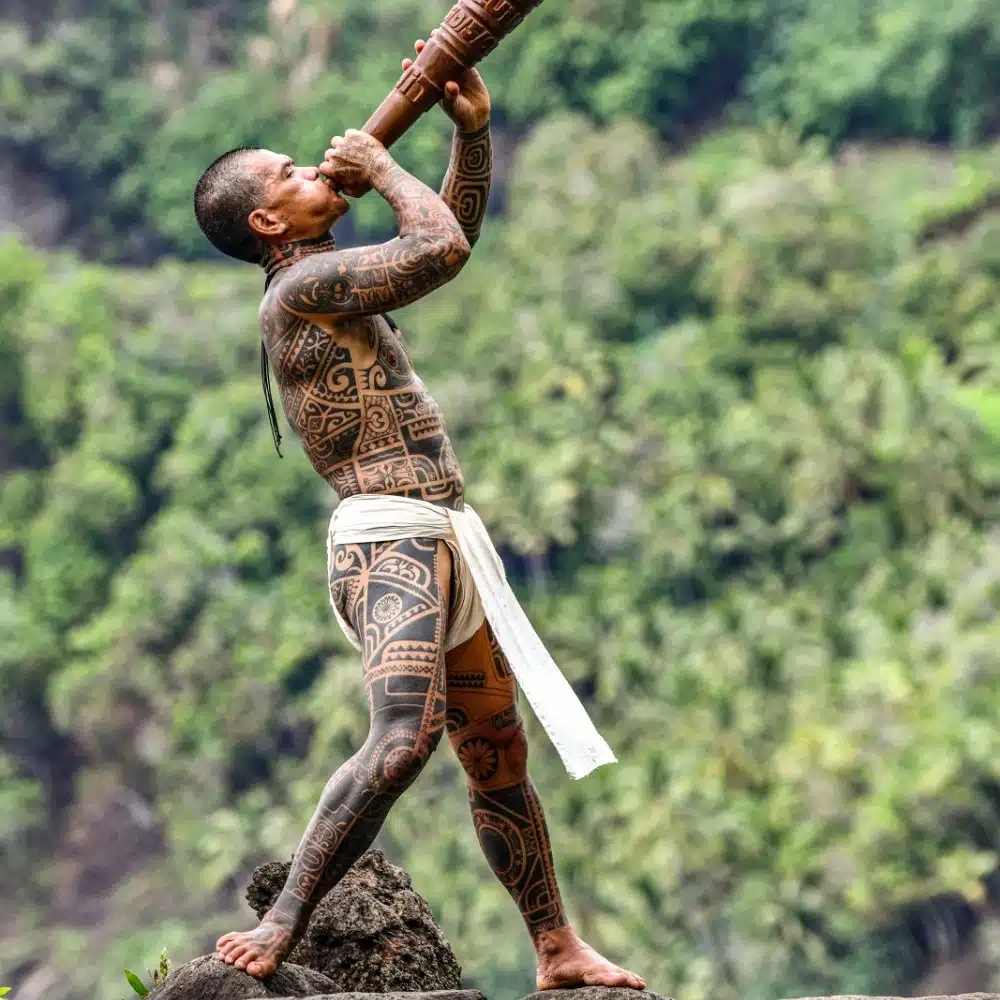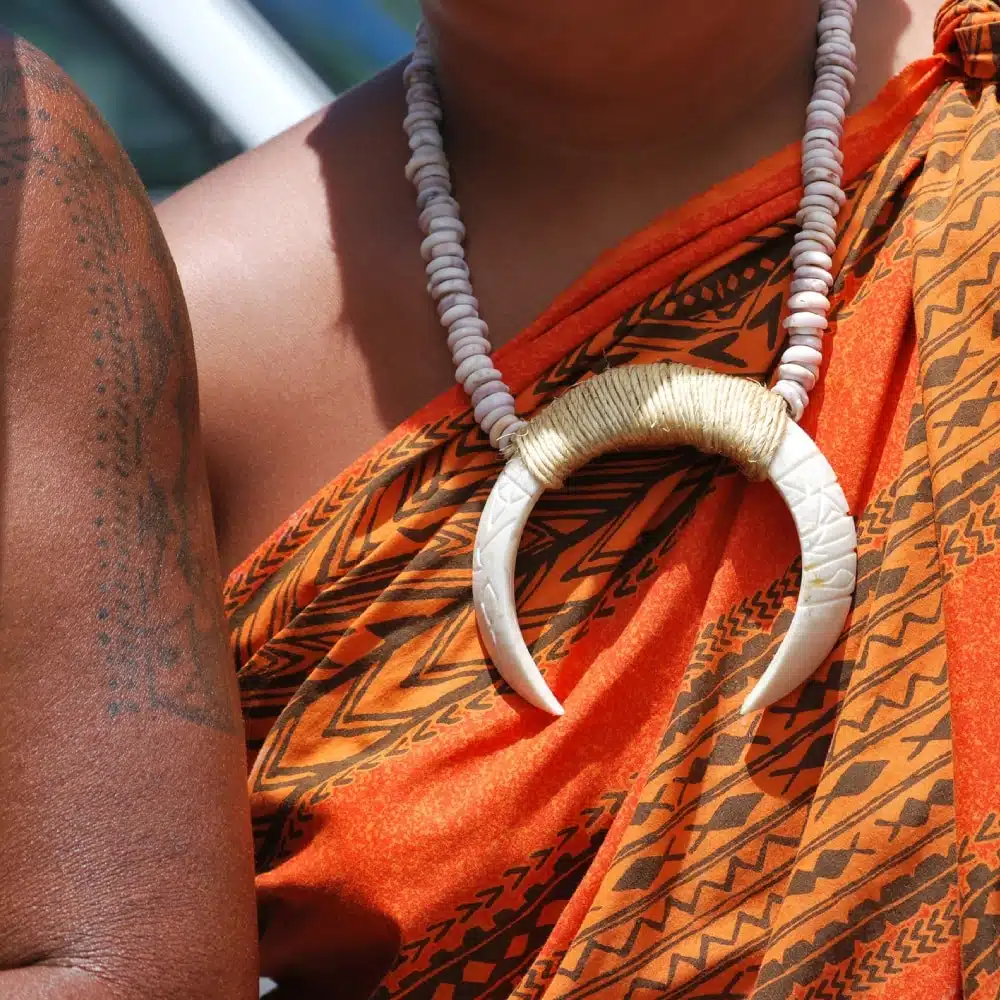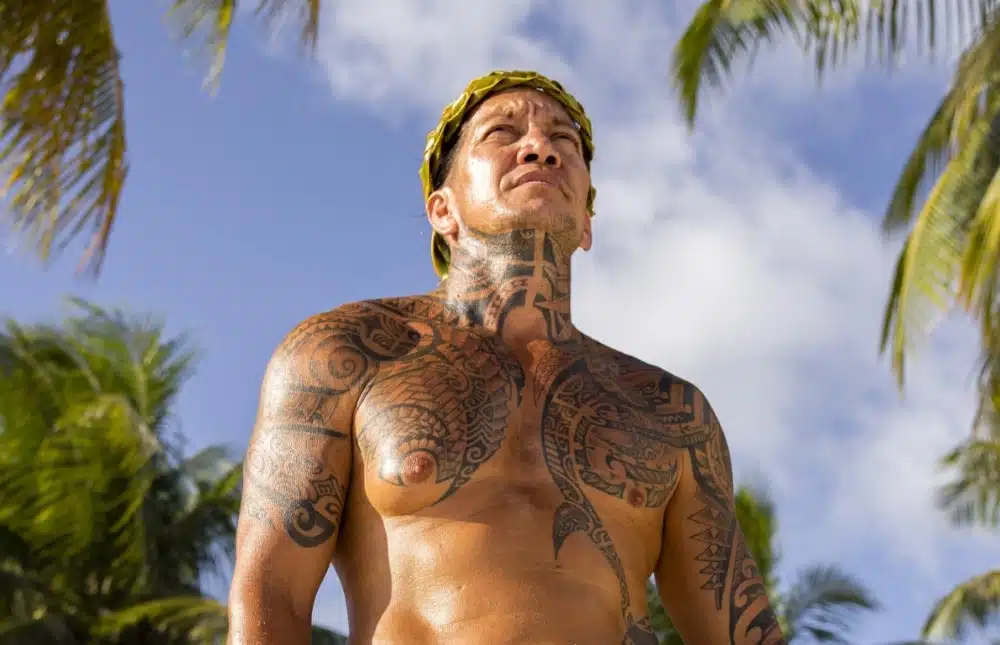Discover an ancestral art
For a personal history of traditional Polynesian tattooing, known as tatau, we turn to Philippe Aukara, a Tahitian tattoo artist based in Papeete, who shares his secrets. The bigger picture focuses on an ancestral art practised for millennia, from the Marquesas Islands to Samoa, via New Zealand and the Society Islands. This invaluable expertise could have died out when it was banned by European settlers, but new artists are committed to preserving its history, techniques and authenticity.
A form of ID
“Ta-tau, ta-tau, ta-tau…” Explorer James Cook heard this mysterious rhythm for the first time during his expedition to Polynesia in the 18th century. It is the “song” of the Polynesian tattoo artist: the sound of their tools clinking together. The tattoo artist uses a mallet to gently hit a wooden handle attached to a small bone, shark tooth or tortoiseshell comb to pierce the skin. The artist will have soaked the teeth of the comb in ink made from candlenut soot, diluted in oil or water, beforehand. In 1769, James Cook – and soon the whole of Europe – discovered these strange blueish drawings covering Polynesians’ arms, torsos, legs and backs.
But Marquesans, Samoans, Tongans, Hawaiians, Tahitians and Māori had been using their bodies as a canvas to “engrave” their history for over two thousand years by that point. Philippe Aukara explains “The tatau was used to express your personality and show your sexual maturity, genealogy or rank in society.” It was a true rite of passage for Polynesians, starting during puberty. Anyone who chose not to follow the tradition was ostracised from the community, but such practices have since been relaxed. Polynesian tattoos were intended to mark an individual’s identity and the passage of time: drawings to make up for the lack of writing within Polynesian societies with oral traditions.

To each their own history
Over the centuries and major migrations within the Polynesian Triangle – Hawaii, New Zealand and Easter Island – each archipelago developed its own art of tattooing. From mountainous islands to atolls with palm trees, styles and symbols vary. It is then up to the individual to tell the important stories of their life and embed their memories in their skin via their favourite totems.
While Marquesan tikis – depictions of the Polynesian half-gods – symbolise protection and power, fish mark prosperity. Turtles evoke health, fertility and family bonds, shark teeth suggest strength and safety, and birds and waves depict travel and spirituality. Ultimately, “each tattoo has its own story. It is primarily the result of a dialogue between the tattoo artist and the person getting the tattoo. It is up to the tattoo artist to arrange the chosen patterns harmoniously and adapt them to the body’s morphology. That’s how the design is gradually built.” There are as many patterns as there are tattoos!
The chosen location is also important. A tattooed shoulder is a sign of strength and bravery, while a tattooed torso symbolises generosity and sincerity. Head tattoos are a sign of wisdom, while leg tattoos represent progress. Customs are changing, but female tattoos are traditionally limited to discreet, delicate adornments on the hands, feet or lips. Take, for example, this small ring of Tahitian gardenia wrapped around an ankle, reflecting grace, beauty and sensuality, or this hibiscus flower on one shoulder.

The rebirth of an art form, respect for a culture
Considered barbaric by missionaries in the late 18th century, the traditional practice of Polynesian tattooing was quickly banned. But its resilience means that the Polynesian islands have seen the tatau regain its reputation almost 150 years later. “It is now fully accepted and embraced. It’s a real leap forward!” says Philippe Aukara with a smile. “Schools and social media are now replacing oral transmission to better share different techniques.”
About Philippe Aukara…
Proud of his roots and culture, Philippe is a worthy heir to the tatau. “As a Marquesan, tattooing and dancing are an important part of my daily life. I’ve wanted to be a tattoo artist and get tattoos since I was very young,” he shares. He practises different tattooing styles in his studio in Papeete opposite Tipaerui high school. In particular, he performs “modern Polynesian tattooing, which is a mix of all the cultures within the Polynesian Triangle, a technique with a lot of shading. And Marquesan tattooing, Patutiki, designed with more black flat tints and no shading.”
Designed directly on his customers’ skin, every one of his creations is unique, an intimate reflection of the life and values of the person with the tattoo. “While I am mainly inspired by traditional Polynesian and Marquesan motifs, as a tattoo artist, I also sometimes update them.” And when it comes to technique, “while the evolution of modern tools has taken over, some people are perpetuating the know-how of our ancestors.” And through it, all the history and culture of Polynesia are kept alive. For example, the dotwork technique is a contemporary version of traditional comb inking.

More than a fashion, the renewal of the tatau is a tremendous affirmation of identity in the heart of the South Pacific… and beyond.
Photos credits : ©Studio PONANT/ Julien Fabro ; ©iStock

PONANT takes you there
Discover ancient traditions



